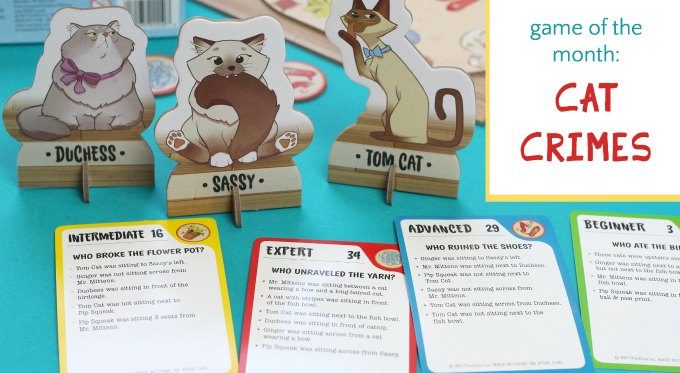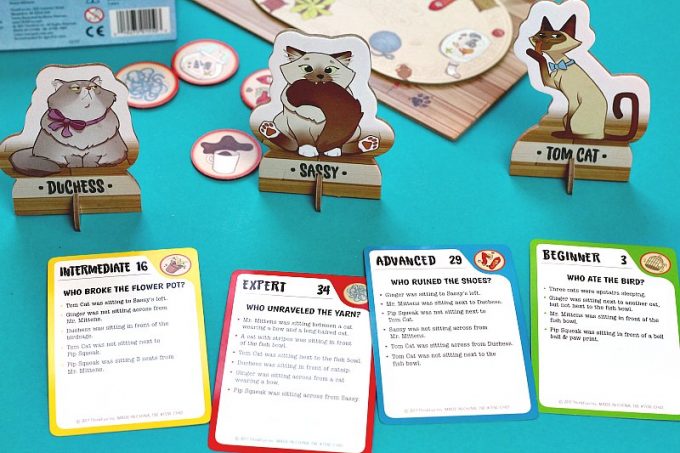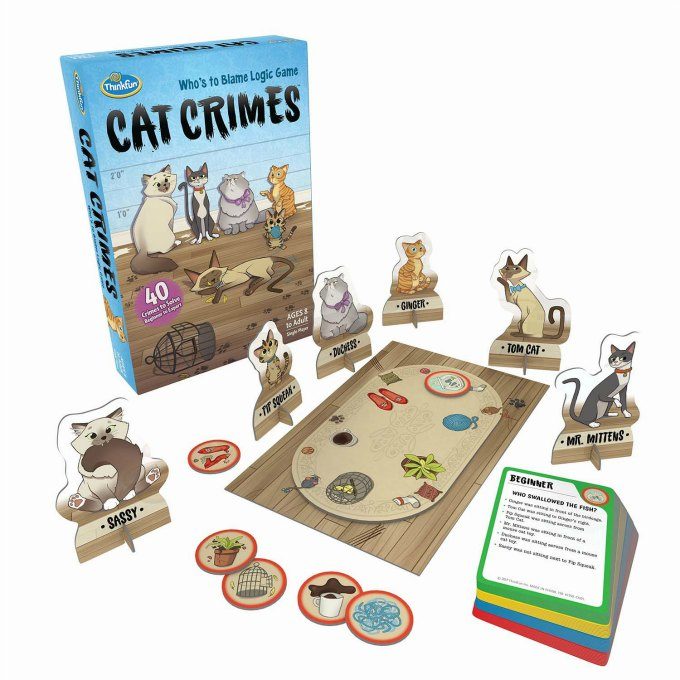I bet you love it when your children can sit down and play a quiet brainteaser or thinking game. You know that they are building their brains and keeping out of mischief at the same time! ThinkFun is one of my favorite go-to game resources because they have a huge repertoire of single player brainteasers and puzzle games.
The Cat Crimes logic game is one of their newest, and my 9 year old is obsessed with it.
And I am obsessed with how busy it keeps him when I want a moment to take care of other business.
Win-Win!

Note: ThinkFun sent us a game for review. This post contains affiliate links. All opinions are truly my own.
UPDATE: you can now also solve canine crimes with Dog Crimes!
How to Play Cat Crimes
Cat Crimes game play will remind you of those paper logic grid puzzles you did as a kid. You know the ones in which you are given a scenario and set of clues. You then must, using deductive reasoning, determine the solution as you fill out the grid. You know what I mean, right? The logic puzzles that look like this:

Cat Crimes operates on the same premise as these logic puzzles, but if your child can't stand those logic grids (like my youngest) he may still love Cat Crimes (as mine did)!
Cat Crimes consists of a game board loosely resembling a room with objects, 6 crime tokens, 6 cats with stands, and a deck of 40 challenge cards ranging from beginner to expert level.
Each challenge card contains a Cat Crime, such as a broken flowerpot or a missing bird and several clues. The player uses the clues to reason out which devious feline is the culprit.

Unlike grid logic puzzles, Cat Crimes allows kids to be hands-on. After drawing a challenge card, they place the corresponding crime token on the board and then as they read through the clues they can place the cats in the correct spots on the board. When the little detectives figure out which cat is placed in front of the crime token, they have solved the mystery. It's sort of a mash-up between Clue and a logic grid puzzle!
Why Kids Should Play Cat Crimes
Two words: SINGLE PLAYER. As I said above, single player games are excellent for keeping kids busy and thinking!
And while you are sipping your coffee, you will know that your kids are exercising their deductive reasoning skills, heading towards reading comprehension mastery, as well improving their visual perception.
Also, you might witness an in real life cat crime:

Because there are multiple levels of puzzles to solve and forty challenge cards, this game will last a long time!
Tips for playing Cat Crimes
Yes, it is a single player game, but you can also play with your kids! In fact, I recommend it. Work on problem solving with your child. Show him that you are willing to work hard even when the answer doesn't come easily. This is a great way to model growth mindset behavior.
Read the instructions thoroughly. All of the cats have bios and the clues on the challenge cards may make use of the bios. In addition, it is important to understand the layout of the game board before diving right in, or you may not place the cats in the correct position.
ThinkFun recommends Cat Crimesfor ages 8 and up. If your child is younger than that and has shown an affinity for logic puzzles, there is no reason to hold off until she is 8. In fact, I recommend you try some of the beginner puzzles out together with your 6 or 7 year olds! Children of all ages may also need a little gentle guidance as the challenges get more difficult.
Find the game here: Cat Crimes
More single player games:





Amy // Sunlit Pages says
I'm so glad to see that Game of the Month is back! My kids LOVE to play games with each other (or alone!), and so we are always looking for new ones. This looks fun!